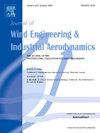Gap effects on the aerodynamic characteristics and flow patterns of a long-span rail-cum-road bridge girder with three separated boxes
IF 4.9
2区 工程技术
Q1 ENGINEERING, CIVIL
Journal of Wind Engineering and Industrial Aerodynamics
Pub Date : 2025-06-24
DOI:10.1016/j.jweia.2025.106137
引用次数: 0
Abstract
Separated box girder configurations enhance flutter stability in long-span bridges but introduce more complex flow interactions within the gaps, potentially inducing vortex-induced vibrations (VIV) at lower wind velocities. This study investigates the effects of gap ratios () on the aerodynamic characteristics and flow patterns of a long-span rail-cum-road bridge girder with three separated boxes. Stationary wind tunnel tests were conducted for ranging from 0.000 to 7.752. Combined time–frequency analysis, pressure measurements, and smoke–wire visualizations revealed distinct flow characteristics for various gap ratio cases. As increased, the upstream and middle box girders successively influenced the flow through vortex impingement on the windward sides of the downstream box girders. When exceeded a critical threshold, the dominant frequency of the wake flow behind the downstream box girder became pronounced, indicating a general reduction in the influence of the upstream wake. The surface pressure distributions corroborated the observed vortex dynamics. Four distinct gap flow patterns were categorized: Pattern A exhibited overshoot flows in both upstream and downstream gaps for to 0.678; Pattern B featured shear layer impingement in the upstream gap combined with vortex impingement in the downstream gap for to 1.260; Pattern C displayed vortex impingement in the upstream gap and a secondary vortex street in the downstream gap for to 1.841; Pattern D demonstrated alternate vortex shedding in both upstream and downstream gaps for to 7.752. The phase lag between the fluctuating lift coefficients of adjacent box girders and the spanwise coherence coefficient elucidated the aerodynamic characteristics of the three-box girder under different gap flow patterns.
间隙对大跨度三箱轨-路桥主梁气动特性及流态的影响
分离式箱梁结构提高了大跨度桥梁的颤振稳定性,但在间隙内引入了更复杂的流动相互作用,可能在低风速下诱发涡激振动(VIV)。本文研究了间隙比(G/H)对大跨度三箱轨-路桥主梁气动特性和流态的影响。在G/H 0.000 ~ 7.752范围内进行了静止风洞试验。结合时频分析、压力测量和烟雾线可视化,揭示了不同间隙比情况下不同的流动特性。随着G/H的增大,上游和中部箱梁先后通过对下游箱梁迎风侧的涡冲击影响流动。当G/H超过临界阈值时,下游箱梁后尾流的主导频率变得明显,表明上游尾流的影响普遍减弱。地表压力分布证实了观测到的涡旋动力学。模式A在G/H=0.000 ~ 0.678范围内,上游和下游间隙均出现超调流量;模式B在G/H=0.775 ~ 1.260范围内,上游间隙为剪切层冲击,下游间隙为涡旋冲击;模式C在G/H=1.357 ~ 1.841范围内,上游间隙存在涡冲击,下游间隙存在二次涡街;模式D显示在G/H=1.938 ~ 7.752时,上游和下游间隙交替发生涡脱落。相邻箱梁升力系数波动与跨向相干系数之间的相位滞后揭示了不同间隙流型下三箱梁的气动特性。
本文章由计算机程序翻译,如有差异,请以英文原文为准。
求助全文
约1分钟内获得全文
求助全文
来源期刊
CiteScore
8.90
自引率
22.90%
发文量
306
审稿时长
4.4 months
期刊介绍:
The objective of the journal is to provide a means for the publication and interchange of information, on an international basis, on all those aspects of wind engineering that are included in the activities of the International Association for Wind Engineering http://www.iawe.org/. These are: social and economic impact of wind effects; wind characteristics and structure, local wind environments, wind loads and structural response, diffusion, pollutant dispersion and matter transport, wind effects on building heat loss and ventilation, wind effects on transport systems, aerodynamic aspects of wind energy generation, and codification of wind effects.
Papers on these subjects describing full-scale measurements, wind-tunnel simulation studies, computational or theoretical methods are published, as well as papers dealing with the development of techniques and apparatus for wind engineering experiments.

 求助内容:
求助内容: 应助结果提醒方式:
应助结果提醒方式:


